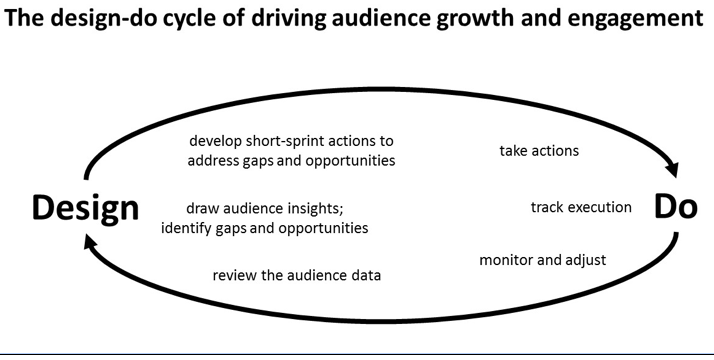Embrace a test-and-learn discipline
Douglas K. Smith, Quentin Hope, Tim Griggs, Knight-Lenfest Newsroom Initiative,This is an excerpt from “Table Stakes: A Manual for Getting in the Game of News,” published Nov. 14, 2017. Read more excerpts here.
Establishing and holding folks in your newsroom accountable for audience traffic and engagement goals will get their attention.
Requiring them to explore, listen, learn from and use an audience-first perspective will help them achieve the traffic and engagement goals through selecting topics, coverage and stories responsive to audience needs, interests and problems to be solved.
This third step – ‘learning by doing’– is your newsroom’s path toward figuring out what works best and most sustainably.
“Learn by doing” means requiring newsroom folks to embrace a continuous, short cycle ‘test and learn’ discipline – something also called ‘design/do.’ In this phrase, ‘design’ means ‘decide’ or ‘choose.’ It means journalists – as individuals and teams – make a clear audience-driven choice about topic, content, story, coverage – as well as platform and publication timing (see Table Stakes #2 and #3) – choices the journalists believe will both serve audiences well and drive success at traffic and engagement goals.
Once the choice is made, ‘do’ means just that: Do it! And see what happens. Does the choice lead to better traffic and engagement? Does it exceed expectations? Fall short? And, in either case, why?

There is a key additional advantage to using this approach: through continuously using design/do, teams, desks, individuals accustom themselves to using and relying on data. As a result, folks in the newsroom learn through experience that the best choices reflect a combination of journalistic experience and intuition and data. In particular, newsroom folks tend to experience a path characterized by:
- Working strictly from gut and assumptions in a manner they have always done … TO
- Seeing some data that, because it’s incomplete and often only shared randomly and episodically leaves folks suspicious of the intent and uncertain of its value … TO
- Accepting that data in the newsroom is here to stay but not being sure how to use it … TO
- Having real-time access to more complete and relevant data in ways that help folks see and use that data as numbers that quickly show what does and doesn’t work tactically at the individual story level (e.g. the impact of having Chartbeat everywhere in the newsroom) … TO
- Understanding data as feedback from audiences and using it to better understand their needs and interests … TO
- Using insights from data to guide what is written and produced for an audience and when … TO
- Embracing data as a means to reach a larger local audience, reach them more often, and serve them better – and doing all this as an integral part of achieving your journalistic mission.